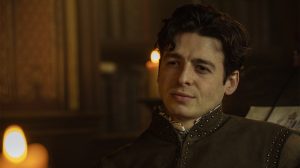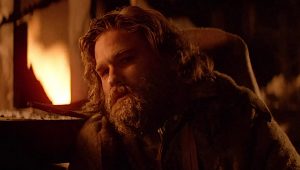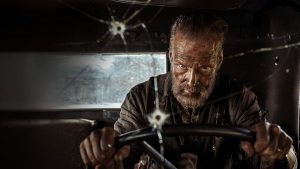
This post contains spoilers for Terrifier 3.
Terrifier 3 is often a joyful movie, and not just because of its Christmas trappings!
That might strike some as a surprising statement. After all, writer/director Damien Leone begins his film with Art the Clown, dressed as Santa Claus, murdering a little girl’s family with an axe. Another sequence climaxes with Art using explosive gifts to blow up a bunch of kids. Yet another is a prolonged sequence of Art spraying an older, good-natured store Santa with liquid nitrogen and then battering away at his body parts.
And yet, Terrifier 3 is joyful, precisely because of the way the store Santa torture sequence begins. After doing some murder, Art passes by a bar where the store Santa (Daniel Roebuck) enjoys a drink with some pals (Clint Howard and Bradley Stryker). Upon seeing the Santa through a window, Art freaks out, scrambling in to meet the man while gesticulating with excitement. There’s something sweet and childlike about Art’s actions. While that does make his penchant for killing children all the more perverse, it also underscores the true pleasure of Terrifier 3 and its two predecessors: David Howard Thornton plays Art with all of the skill and excitement of a classic silent comedian.
For all of his stomach-churning mayhem, Art’s true ancestors are less Freddy and Jason, and more Buster and Charlie. These performers who know how to use their bodies and expressions to great effect, an effect that often clashes (intentionally, to be sure) with the nastiness of their actions.
Chaos and Cruelty in Classic Cinema
Art is hardly the only taciturn clown to threaten people with explosives. In the 1922 single-reel comedy “Cops,” a lovelorn poor man played by Buster Keaton drives a horse-drawn cart into the town square. Surrounded by police officers, Buster tries to take the edge off with a cigarette. As he searches for a light, a bomb lands in his lap, thrown by a pair of anarchists above. Without missing a beat, the stone faced Buster lights up his cigarette and tosses the bomb behind him. The bomb explodes and the furious cops retaliate, chasing him until a closing title card that shows Buster’s porkpie hat tilted atop a gravestone.
Today, Buster’s bombing plays like a cartoonish bit of physical comedy, not unlike the way he see-saws on a ladder later in the short. But to the original audience more than a century ago, the bomb sequence struck a nerve. Anarchist bomb threats throughout 1919 were still in the public consciousness, as was the assassination of President William McKinley by anarchist Leon Czolgosz in 1901. Furthermore, the waves of police who attack Buster in retaliation brings to mind the Haymarket Riot of 1886 when Chicago cops brutalized striking workers.
Thus Buster’s gags were just as much horror as they were comedy, at least to the first viewers.
And he was hardly the only comedian of the era to combine physical humor with hot-button issues. A decade earlier, Keystone Studios pumped out split-reel comedies with violent, bumbling officers dubbed the Keystone Cops. While the Cops usually engaged in pratfalls and pie in the face gags, their adventures did sometimes turn shockingly violent. “Bangville Police” (1913) sees parents nearly shoot their daughter, confusing her for burglars. Next year’s “Barney Oldfield’s Race for a Life” stars real-life race car driver Barney Oldfield and Keystone sweetheart Mabel Normand in a short that ends with the cops being shot to death by villains. Then there’s perhaps the biggest name of the bunch, Charlie Chaplin, a Keystone graduate who consciously married political commentary with slapstick comedy. Like Buster, Chaplin’s Tramp becomes entangled with protesting workers and a police backlash in Modern Times (1936). That same film finds the Tramp caught in the gears of a machine, a real danger for many Americans who worked in unsafe factories.
Time and changing mores may have dulled the shocking nature of these gags, but rest assured, they are shocking. Mean-spirited and boundary-pushing, these gags took terror and made it joyful. And that’s exactly what Thornton does with his performance as Art the Clown.
The Art of Art the Clown
In one of Terrifier 3‘s many gnarly set-pieces, Art comes across two young people having sex in a locker room shower and proceeds to hack the couple to pieces with a chainsaw. Yes, it is grotesque and cruel, lasting several minutes and filled with close-ups of the teens begging for mercy as Art mutilates their bodies.
But it’s also really, really funny in an old-timey way. After getting his leg slashed by the chainsaw blade, Cole (Mason Mecartea) attempts to run out of the shower, only for his calf to fall apart when he steps down. Art leans back in silent laughter, pointing at the kid like he’s cackling at a rich person who just got a pie in the face. After reducing Mia’s (Alexa Blair Robertson) face to strips of flesh, Art kneels down and stares at his handiwork, not with the passionless distance of Michael Myers killing a boyfriend in Halloween, but with the glee of a suburban mom who just finished her holiday decorations. He gives what remains of Mia’s nose a little “boop,” complete with a sweet shoulder shrug, and returns to Cole.
Cole tries to crawl away, but Art grabs his ankle to pull him back. But when the tattered tendons give way and the calf rips off. Never one to miss a bit, Art pulls the calf up to his face and sniffs the foot. He recoils at the smell, a full body bit of repulsion missing from all of the other unspeakable acts Art’s inflicted on others.
As upsetting and mean as Art’s mutilation of Cole and Mia certainly is, he also makes it really funny. In fact, Thornton’s classical clowning chops almost have a wholesome, cartoony energy that has the opposite effect of nearly every other part of the Terrifier series. Instead of making the onscreen mayhem so much worse, Art’s shenanigans cut the tension and the terror. It’s like he’s winking to the audience and reminding them all that actors Mecartea and Robertson are just fine, that no kids were cut up, and this is all in good fun.
Comedy in the Cruelty
Are Art’s antics cruel? Yes, of course.
Terrifer 3 wants so badly to offend its viewers, which is why it begins with a family’s murder, features a horribly disfigured woman named Victoria (Samantha Scaffidi) gnawing off an umbilical cord attached to Art’s head (to which she just gave birth), and climaxes with Victoria recreating Catholic imagery, complete with a crown of thorns pushed into final girl Sienna’s (Lauren LaVera) head and a decapitated victim’s body nailed to the wall with stigmata-style wounds.
As with the demon girl and the extended children’s show segment from Terrifier 2, these films want so badly to push viewers’ buttons. And yet, more often than not, the extreme content feels like one-note edginess, no deeper than a pre-teen hurling swear words at their parents. It might annoy some people, but most of these scenes are obvious in their desire to upset. Where the Terrifier franchise fails to offend, they do manage to be fun and silly, thanks entirely to Thornton’s performance. As demonstrated by the bloody angel he makes in the viscera left after killing Mia and Cole, there’s joy to be had in Terrifier 3, joy beyond, and sometimes within, its extreme gore.
Terrifer 3 is now in theaters.
The post The Joy of Terrifier 3 Goes Far Beyond the Gore appeared first on Den of Geek.






